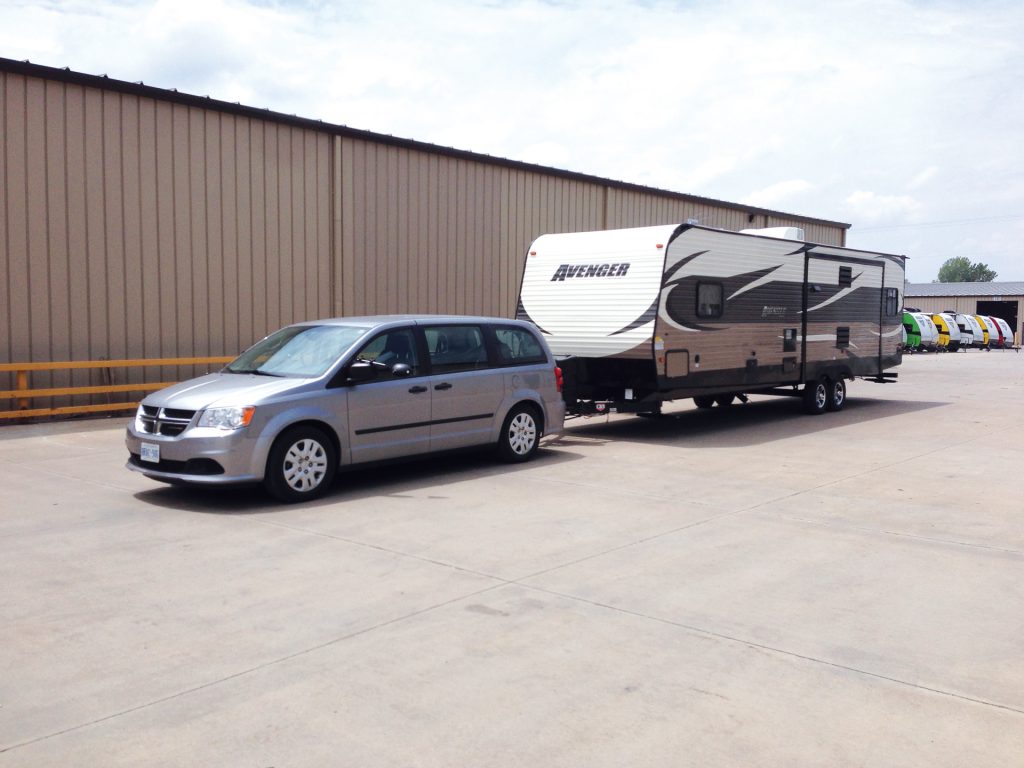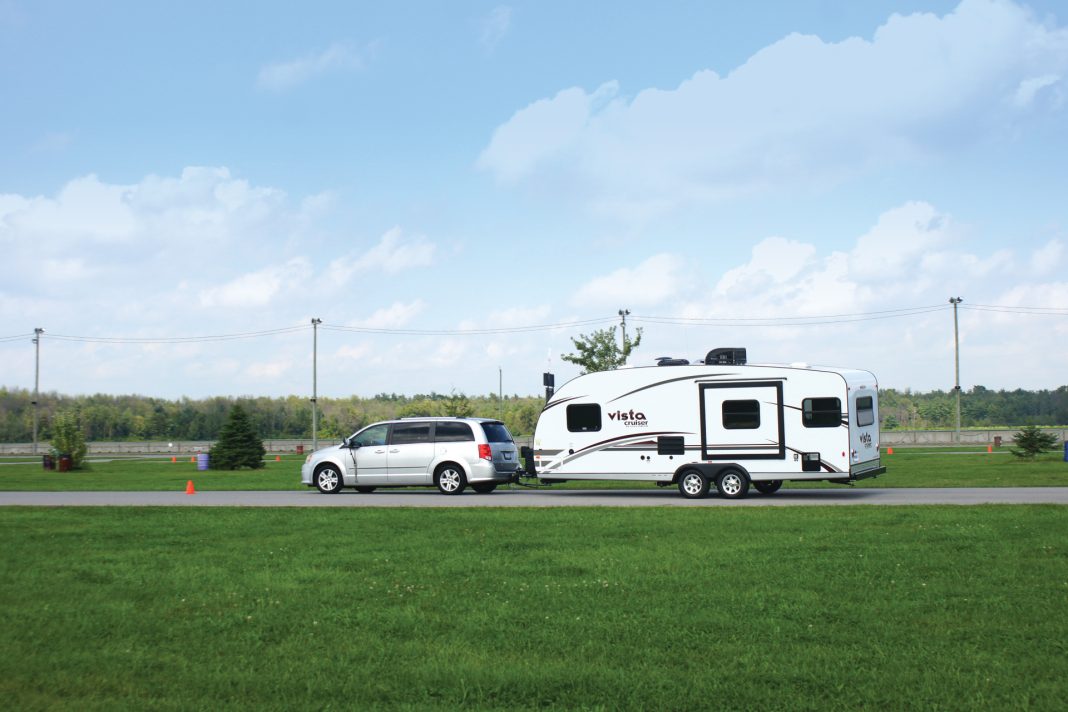
Our 2014 Dodge Caravan has 200,000 kilometres on it most of those have been spent towing and many of those kilometres are towing trailers that are harder to tow than we would send customers out with. Every week or two the Caravan does a trip to Indiana to sort out parts problems, so it often gets loaded to the ceiling with parts and then we pick up a trailer from one of our suppliers. Often, the trailer it picks up will not be the ideal trailer for the Caravan to tow, sometimes it’s too tall with less than ideal aerodynamics. This means the Caravan tows back to Canada in 3rd gear at 3500 RPM at close to full throttle. However, it just keeps doing it trip after trip. Considering the van only cost $20,000 to buy, it owes us nothing. The other great thing about the Caravan is that the solo fuel economy is quite good, so we spend less on fuel than we would running any other vehicle that can carry what the Caravan does. Out of all our customers we rarely, if ever, see a customer wear out the drivetrain on a tow vehicle. These days with fuel injection and synthetic lubricants, people replace a vehicle because they are bored with it or it has other issues electronics etc.
60% of the kilometres on our Caravan are towing kilometres, the typical RV owner is likely to tow about 20% of their vehicles kilometres. As long as you are sensible about how you drive your vehicle and maintain the fluids you will likely never wear it out due to towing. We very rarely hear of driveline problems from any of our customers. Yet I sometimes hear people say: “I like my tow vehicle, but I think it is working too hard.” I often wonder what they base that on as I know few of them aren’t working as hard or as much as our Caravan. The other question is how do you know if it is working too hard?
For example, we had customer in a couple of weeks ago. They tow a 23’ Vista Cruiser, which is a pretty aerodynamic trailer at 7’6” wide with a tear drop roof. The Caravan tows it in 4th and 5th gear. They were in getting their new F-150 EcoBoost set up with the Vista Cruiser. Their previous tow vehicle was a Toyota Tacoma with a 4.0 Litre V6. I asked if they wanted the larger cab or the quieter interior of the F-150 when considering a tow vehicle instead of the Tacoma. They said they really liked their Tacoma and was a better size for them most of the time, but they just thought it is was working too hard. In reality, I don’t think it would be possible to work a 4.0 Litre Tacoma too hard, it has one of the most proven, indestructible engines made.
 The ironic thing is that their new F-150 EcoBoost is actually working harder, not that it will bother it, it just isn’t perceived to be. The F-150 needs more power to push it down the road than the Tacoma does, because it is a larger vehicle it needs to do more work, both towing and solo, to accomplish the same speed as the Tacoma. The F-150’s engine is actually smaller, 3.5 Litre vs. the Tacoma’s 4.0 Litre, it does not feel smaller due to the turbochargers pumping extra fuel and air into the engine, but nevertheless the internal combustion pressures and temperatures will be much higher than in the 4.0 V6 Tacoma. So, in reality, their perception that the Tacoma was working harder was just that; a perception. Ford has done many things to the EcoBoost to help it deal with the internal heat and pressure of running in boost all the time, and we have not seen any durability issues with them. Some of our customers are over 250,000 kilometres on their EcoBoost F-150’s with no issues, so I am not saying the EcoBoost is asking for trouble, I am trying to illustrate that perception of how hard a vehicle works is rarely the reality. Still if you connected a Vista Cruiser to both trucks and just kept driving them until one of them died the F-150 in theory would not last as long as the Tacoma. However, the reality is the owner will likely trade either truck hundreds of thousands of kilometres before it reaches that point.
The ironic thing is that their new F-150 EcoBoost is actually working harder, not that it will bother it, it just isn’t perceived to be. The F-150 needs more power to push it down the road than the Tacoma does, because it is a larger vehicle it needs to do more work, both towing and solo, to accomplish the same speed as the Tacoma. The F-150’s engine is actually smaller, 3.5 Litre vs. the Tacoma’s 4.0 Litre, it does not feel smaller due to the turbochargers pumping extra fuel and air into the engine, but nevertheless the internal combustion pressures and temperatures will be much higher than in the 4.0 V6 Tacoma. So, in reality, their perception that the Tacoma was working harder was just that; a perception. Ford has done many things to the EcoBoost to help it deal with the internal heat and pressure of running in boost all the time, and we have not seen any durability issues with them. Some of our customers are over 250,000 kilometres on their EcoBoost F-150’s with no issues, so I am not saying the EcoBoost is asking for trouble, I am trying to illustrate that perception of how hard a vehicle works is rarely the reality. Still if you connected a Vista Cruiser to both trucks and just kept driving them until one of them died the F-150 in theory would not last as long as the Tacoma. However, the reality is the owner will likely trade either truck hundreds of thousands of kilometres before it reaches that point.
On our vehicles we change the engine oil every 5-10,000 kilometres. If they are doing a lot of short test drives or local delivery trips, then oil changes are closer to 5,000 km. With a lot of highway usage, then we change the oil every 10,000. We replace transmission fluid and axle fluids every 60-80,000, again depending on usage. We may change fluids more often than necessary but at the price of an engine or transmission, I would rather err on the side of caution.
So, how do you know if your vehicle is working too hard?
The most common driveline issues we see are with the differentials on rear drive vehicles. On a front drive vehicle the final drive is part of the transaxle so it is cooled by the transmission fluid being pumped through the cooler. On a rear drive the final drive is all alone in the air at the back of the truck and you actually have no way to know the actual temperature of the differential. As engine power has increased the differentials have not really grown in size so it is surprisingly easy to overheat one. In the old days if you were pulling a trailer in a headwind the lack of power kept you down to 90-95 KPH. Today’s motors will pull through the headwind at 110 KPH which can cause the axle to get quite warm. One way to test the axle temp is with an infrared thermometer, you can aim these at the axle from the side of the truck when you pull off the highway and get a temperature reading. This reading won’t be super accurate, but it will give you an idea. If you are reading much over degrees on the outside of the axle housing it is likely a good idea to slow down a little. You will save a bunch of fuel as well.
One item that may play a role in rear axle heat is the effect of the trailer on the air flow under the truck. If the trailer is creating a back pressure by the bumper then less air may be flowing over the rear axle. This appears to be more of an issue when the bottom front of the trailer is lower than the bottom of the truck. This would seem to make sense, though I have no data or wind tunnel to back up that statement.
Now that we are talking about digital thermometers, they are also handy for reading tire and transmission temperatures as well. To read the transmission you can pull out the dip stick if you have one and read the tip of it. If not you can read the cooler lines where they go in or out of the radiator. Most transmissions today are being designed to operate with the torque convertor locked 90% of the time so transmissions tend to run considerably more consistent temperatures than they used to.
Another handy thing you can do with a digital thermometer is read the temperature of your trailer brake drums after a stop to check that all the brakes are working. Electric brakes will never be perfectly even so don’t be surprised to see 20°C difference between wheels.
If you want to check your trailer wheel bearing temperatures, it’s a little more involved. Applying the brakes, will of course, heat the hubs up. The easy place to check the bearings is a rest area that you can largely coast into. This way you don’t apply the brakes and heat the drums, letting you read the actual wheel bearing temperatures. These should be fairly consistent and only around 20°C warmer than the ambient air.
In conclusion, before you spend thousands of dollars on a perceived reality, check some temperatures and see if your vehicle really is working too hard.






















